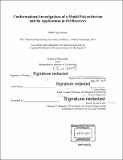| dc.contributor.advisor | T. Alan Hatton. | en_US |
| dc.contributor.author | Ranka, Mikhil Ajay | en_US |
| dc.contributor.other | Massachusetts Institute of Technology. Department of Chemical Engineering. | en_US |
| dc.date.accessioned | 2018-05-17T19:07:41Z | |
| dc.date.available | 2018-05-17T19:07:41Z | |
| dc.date.issued | 2017 | en_US |
| dc.identifier.uri | http://hdl.handle.net/1721.1/115467 | |
| dc.description | Thesis: Ph. D., Massachusetts Institute of Technology, Department of Chemical Engineering, June 2017. | en_US |
| dc.description | Cataloged from PDF version of thesis. "June 2017"--Handwritten on title page. | en_US |
| dc.description | Includes bibliographical references. | en_US |
| dc.description.abstract | In recent years, nanoparticles have demonstrated immense promise for the development of next generation technologies for subsurface reservoir characterization and oil recovery. Until now however, the scope of such nanoparticles has been limited due to the significant challenge of colloidal stabilization under the extreme salinity and high temperature conditions typical of a reservoir. Previous efforts to address this problem have focused on conventional polyelectrolyte based stabilizers, which unfortunately fail at high ionic strengths due to excessive charge screening. In this thesis, we demonstrate a new approach to stabilization that overcomes this key deficiency, by specifically taking advantage of the excessive charge screening afforded by high ionic strengths. The approach is based on the anti-polyelectrolyte phenomenon, in which screening of intra-chain electrostatic interactions causes a polyzwitterion to undergo a structural transition from a collapsed globule to a more open coil-like regime. We first fundamentally investigate the anti-polyelectrolyte phenomenon in a high density comb type polyzwitterion, poly(sulfobetaine methacrylamide) (polySBMA), via small angle neutron scattering. The phenomenon is probed at a range of molecular weights by utilizing low dispersity homopolymers synthesized via controlled radical polymerization methods. Unique non gaussian behavior with significant molecular weight dependencies of size and shape is observed. An electrostatic dependence for Kuhn length is also established. Subsequently, we extend our understanding of anti-polyelectrolyte systems by characterizing the conformational dependence of polySBMA under conditions such that its responsive swelling is confined due to the segments being bound in three, six and twelve armed star architectures. Chain stretching due to solid angle exclusion, as well as, strong dependencies of size and fractal dimension on electrolyte concentration, number of arms and degree of polymerization (per arm) are noted. After gaining a detailed insight of the anti-polyelectrolyte phenomenon, its unique osmotic response is engineered into electrolyte and temperature responsive polyzwitterionic stabilizers. Robust colloidal stability of silica and polystyrene nanoparticles under reservoir relevant conditions is demonstrated, and the design principles of developing colloidally stable nanoparticles are elucidated. Finally, the polyzwitterion functionalized nanoparticles are leveraged in the form of schizophrenic diblock copolymer functionalized nanoparticles, to develop temperature tunable pickering emulsifiers. In contrast to conventional temperature responsive pickering emulsifiers, which induce phase separation upon heating, the schizophrenic diblock copolymer functionalized nanoparticles are demonstrated to function in the reverse direction, by inducing demulsification upon cooling. The unique temperature response is noted to be cyclable, and is likely to render the particles of important utility in enhanced oil recovery demulsification. | en_US |
| dc.description.statementofresponsibility | by Mikhil Ajay Ranka. | en_US |
| dc.format.extent | 114 pages | en_US |
| dc.language.iso | eng | en_US |
| dc.publisher | Massachusetts Institute of Technology | en_US |
| dc.rights | MIT theses are protected by copyright. They may be viewed, downloaded, or printed from this source but further reproduction or distribution in any format is prohibited without written permission. | en_US |
| dc.rights.uri | http://dspace.mit.edu/handle/1721.1/7582 | en_US |
| dc.subject | Chemical Engineering. | en_US |
| dc.title | Conformational investigations of a model polyzwitterion and its applications in oil recovery | en_US |
| dc.type | Thesis | en_US |
| dc.description.degree | Ph. D. | en_US |
| dc.contributor.department | Massachusetts Institute of Technology. Department of Chemical Engineering | |
| dc.identifier.oclc | 1035552957 | en_US |
